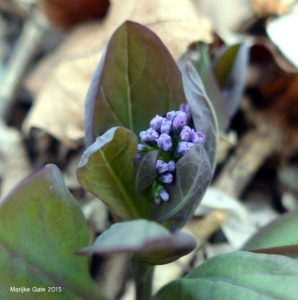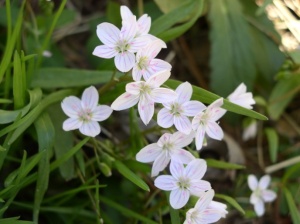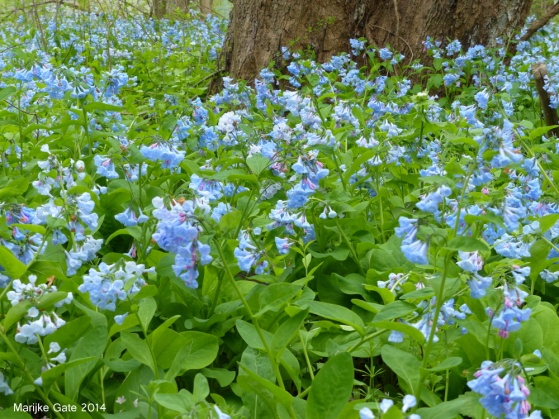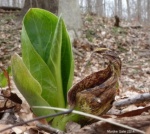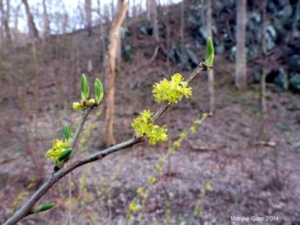Update: April 8, 2015
 Blue is the color of April at Riverbend Park. The Virginia Bluebells are bursting into bloom and the Eastern Bluebirds are busy checking out nest boxes as they search for a good nesting site. On Saturday April 4 only a few bluebell plants were flowering, but as the warmer weather continues more and more are beginning to open. By April 8 approximately 20% were in bloom. Before they open the flower buds are a pinkish blue. Once the flowers are fully open they are a beautiful light blue, and as they fade after pollination they may turn slightly pink again. Look closely and you may see some pink or white flowers amidst the mass of blue. As the warmer weather continues look for bumblebees visiting the flowers and hanging upside down under the blooms or hovering nearby as they insert their long “tongue”, or proboscis, into the blossom in search of nectar and pollen. Bumblebees are popular pollinators in the spring ephemeral world, in part because they can be found flying at temperatures as low as 41 degrees which makes them ideal pollinators for these early spring bloomers. The bumblebee also benefits by collecting pollen and nectar with which to stock her new nest.
Blue is the color of April at Riverbend Park. The Virginia Bluebells are bursting into bloom and the Eastern Bluebirds are busy checking out nest boxes as they search for a good nesting site. On Saturday April 4 only a few bluebell plants were flowering, but as the warmer weather continues more and more are beginning to open. By April 8 approximately 20% were in bloom. Before they open the flower buds are a pinkish blue. Once the flowers are fully open they are a beautiful light blue, and as they fade after pollination they may turn slightly pink again. Look closely and you may see some pink or white flowers amidst the mass of blue. As the warmer weather continues look for bumblebees visiting the flowers and hanging upside down under the blooms or hovering nearby as they insert their long “tongue”, or proboscis, into the blossom in search of nectar and pollen. Bumblebees are popular pollinators in the spring ephemeral world, in part because they can be found flying at temperatures as low as 41 degrees which makes them ideal pollinators for these early spring bloomers. The bumblebee also benefits by collecting pollen and nectar with which to stock her new nest.
Virginia Bluebells in bloom along the floodplain
Other spring ephemerals are also beginning to put on a show. Spring Beauties are springing up everywhere, on the floodplain and woodland banks alike. The showy but fragile Bloodroot (Sanguinaria candensis) is making an appearance on some of the drier parts of the Potomac Heritage Trail. These lovely plants have a single leaf which clasps the stem and which persists long after the flower has vanished, increasing in size for many weeks as it produces food for winter storage in the underground rhizome. The many petaled flowers are very striking but are also subject to changes in the weather. A heavy rain or wind storm will see the end of these flowers and so they must be pollinated and set seed as soon as possible.
Like many of our native wildflowers Bloodroot seeds are dispersed by ants which are attracted to a small fat body – the Eliasome – that is attached to the seed. The ants carry off the seed to their nest, where they eat the eliasome and discard the seed in or around the colony, where it is free to germinate in the rich ground.
And let’s not forget the Eastern Bluebirds (Sialis sialis) busily prospecting for desirable spring residences, zipping around in their smart blue and red spring plumage. Check out some of our many nest boxes near the Visitor Center and in the Meadow and you may see a Bluebird sitting on top of the box scanning for insects.
Bluebirds are quite sociable little birds and can often be seen on top of the boxes near the picnic areas. They prefer boxes that face an open meadow or green space, where they can easily see their insect prey. Last year one bird even took a fancy to the wing mirror of one of our naturalists’ cars and spent many happy hours perched there surveying the parking lot. Riverbend Park’s Bluebird boxes are monitored throughout the summer by volunteer monitors, and this is a fun way to learn more about these and some of our other cavity nesting birds such as Chickadees and Tree Swallows.
If you are interested in becoming a Bluebird box monitor contact Marijke Gate at Riverbend Park at 703-7598-9018.
For more information on these or any of our spring activities call 703-759-9018 or view our website at www.fairfaxcounty.gov/parks/riverbend
Check back for regular updates on the Bluebells’ progress.
Marijke Gate, Naturalist at Riverbend Park
Update: March 30, 2015
The Bluebells Make Their Debut
Virginia Bluebells are coming up everywhere along the banks of the Potomac. On March 15 we saw the emergence of the first purple leaves through the sand and dead leaves littering the floodplain. The deep purple color rapidly turns to green as the leaves develop. Just one week later the first buds were spotted, protected by the new leaves, and schoolchildren on a field trip were excitedly pointing out the hundreds of plants dotting the bare winter earth. Soon the plants will cover the ground with their large green leaves and the buds will blossom into beautiful blue flowers. Although called Bluebells they are not related to the bluebells of the English countryside, or the harebells of Scotland. Members of the Borage family, they are also known as the Virginia Cowslip. The drooping nature of the flowers helps to protect the pollen and nectar on rainy days.
The tiny purple shoots that emerge from the soil soon become greenish leaves
The Bluebells are accompanied by the bright green shoots of Ramps or the Wild Leek (Allium tricoccum). These can be easily identified by breaking off a piece of the leaf and sniffing. It has a very pungent onion smell and is a great favorite as a spring food. All parts of the plant can be used like garlic or onion, and there are hundreds of Ramps recipes. There are even Ramps festivals in the mountains of Virginia, West Virginia and Tennessee. The word Ramps is thought to come from the old English word ransom. Ramps are unusual in that the leaves develop during the spring and form large clumps, and then die back in early summer. The white, onion-like flowers then appear in June and July.
Ramps leaves form large clumps in spring before dying back and giving way to the white flowers produced in summer.
Spring has come late this year, and the first wildflower blooms were only seen in late March with the appearance of the tiny flowers of Harbinger of Spring (Erigenia bulbosa). This tiny plant is one of our earliest spring bloomers and can only be spotted by careful examination of the leaf litter in drier areas of the river bank. Once you have seen one you will be able to see hundreds of the plants with their five tiny white petals, deep red stamens and deep green, divided leaves. Like many of our native spring ephemerals, such as Spring Beauty (Claytonia virginica), the Harbinger of Spring develops from a small underground bulb or corm. The corm and other parts of the plant were once chewed to alleviate toothache.
Spring Beauty, aka Fairy Spuds, a common companion plant to both Virginia Bluebells and Harbinger of Spring, is also becoming visible along the floodplain. The small white or pink flower is open on sunny days but closes when it’s shady or when it rains. This helps to protect the pollen and nectar for the small flies and other early insects that help to pollinate the plants. Look for the small, grass-like leaves of the Spring Beauty scattered throughout the floodplain and the nearby woodland areas. In a few weeks you will be able to see large swaths of Spring Beauty carpeting the banks of the Potomac. The corms would be dug up and roasted to provide a spring treat for Native Americans.
The Potomac River is also showing signs of spring. The air is filled with the call of Ring-Billed Gulls (Larus delawarensis) as they float down the river and then fly back upstream, snapping up the Stoneflies that are emerging from the water in massive numbers. Pairs of Common Merganser (Mergus merganser), strikingly beautiful fish-eating ducks, are beginning their courtship in preparation for nesting, and perky little Buffleheads (Bucephala albeola) are still dashing about the river in search of food before heading north to their breeding grounds. Spring warblers will be moving in any day and Eastern Bluebirds are prospecting nest boxes to complete nature’s buffet that is Riverbend Park in the spring.
Don’t forget to join us on Saturday April 11, 2015, from 10 a.m. to 2 p.m. for our third annual Bluebell Festival. Come celebrate the return of the Bluebells and the arrival of spring with activities for all the family including wildflower walks, face painting, live animals, wagon rides, live music and other family fun activities.
Naturalist led Spring Wildflower Walks at Riverbend Park on April 4 and Scotts Run Nature Preserve on April 23 are a great way to get to know these lovely spring flowers and discover the folklore associated with them.
For more information on these or any of our spring activities call 703-759-9018 or view our website at www.fairfaxcounty.gov/parks/riverbend
Check back for regular updates on the Bluebells’ progress.
Written by Marijke Gate, Naturalist at Riverbend Park
The Bluebells are coming. There’s still some snow on the ground and the wind chills have been at record levels, so it may seem strange to be thinking about Bluebells, but spring will soon be upon us despite the dire predictions of the groundhog. Our spring ephemerals are getting ready to put on their annual show and in a few weeks the floodplains of Riverbend Park will be carpeted in blue as the Virginia Bluebells (Mertensia virginica) reach their peak. They are already preparing to send their early purple shoots up into the light, along with the many other species of native spring wildflowers that grace the banks of the Potomac River. The rich floodplain soils are host to numerous wildflower species, such as Spring Beauty, Bloodroot and Trout Lily, that take advantage of the early spring sunlight that falls to the forest floor before the trees have fully leafed out.
The Virginia Bluebell, also known as the Oysterleaf (for the faint taste of oysters released by chewing the mature leaves) and the Lungwort (for its supposed efficacy in treating lung ailments), produces masses of drooping blue flowers for several weeks in the spring.
The plant thrives in the moist soil of the floodplain and is one our most showy spring blooms. Unlike the Cherry blossoms, peak Bluebell blooming can be difficult to predict so watch this space for regular updates on the plants’ progress.
While waiting for the Bluebells to appear take a walk along the trails of Riverbend Park and you will find some early signs of spring. Look up to see the flower buds of the Red Maple (Acer rubrum) ready to burst into bloom on the next warm day.
Look down as you walk along a stream or creek and you may find signs of our earliest wildflower, the Skunk cabbage (Symplocarpus foetida), as it pushes its brownish-purple spathe through the snow and ice.
Skunk cabbage (break off one of its leaves later in the season and you will understand why it is so named) generates enough heat to penetrate the frozen winter earth. Look inside the pod-like spathe and you will see the small yellow flowers carried on the spadix, ready to be pollinated by the flies that are attracted by the plant’s foul smell.
A walk along the Potomac Heritage Trail will lead you past Northern spicebush (Lindera benzoin) with its delicate yellow flowers blooming right on the twigs. Gently scratch the bark to release the aromatic scent that gives Spicebush its name. Native Americans used all parts of the plant to make tea and to add spice to their food.
As spring progresses different wildflower species come to the fore while early bloomers begin to fade. By late spring there will be little trace of these “ephemeral” plants as the more showy summer flowers take their place. Make sure to come out during the spring months to watch the parade of early wildflowers that make Riverbend such a special place.
Join us on Saturday, April 11, 2015 from 10 a.m. to 2 p.m. for our third annual Bluebell Festival and celebrate the return of the Bluebells and the arrival of spring with activities for all the family including wildflower walks, face painting, live animals, wagon rides, live music and other family fun activities in celebration of spring. Bluebell Festival: $5 per person. Wildflower Walks: $6.
Naturalist led Spring Wildflower Walks at Riverbend Park (April 4) and Scotts Run Nature Preserve (April 23) are a great way to get to know these lovely harbingers of spring, and discover the folklore associated with them.
For more information on these or any of our spring activities call 703-759-9018 or view our website at www.fairfaxcounty.gov/parks/riverbend-park/
Check back for regular updates on the Bluebells’ progress.
Author and photographer Marijke Gate, is a Naturalist at Riverbend Park










